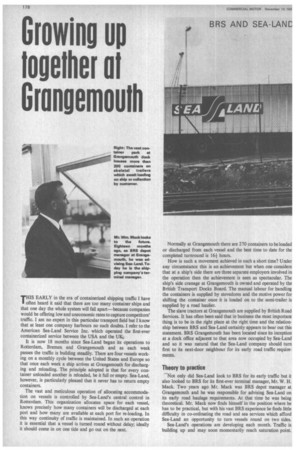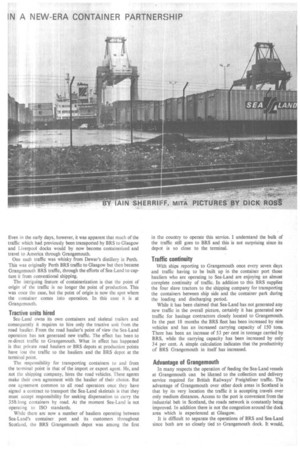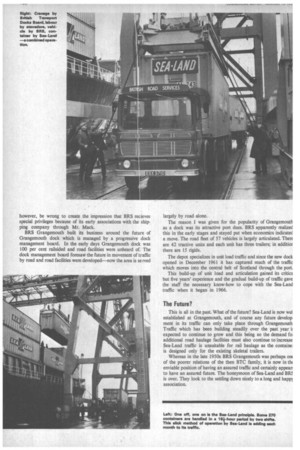Growing up together of Grangemouth
Page 180

Page 181

Page 182

If you've noticed an error in this article please click here to report it so we can fix it.
T HIS EARLY in the era of containerized shipping traffic I have I often heard it said that there are too many container ships and that one day the whole system will fall apart—because companies would be offering low and uneconomic rates to capture competitors' traffic. I am no expert in this particular transport field but I know that at least one company harbours no such doubts. I refer to the American Sea-Land Service Inc. which operated the first-ever containerized service between the USA and the UK.
It is now 18 months since Sea-Land began its operations to Rotterdam, Bremen. and Grangemouth and as each week passes the traffic is building steadily. There are four vessels working on a monthly cycle between the United States and Europe so that once each week a ship arrives at Grangemouth for discharging and reloading. The principle adopted is that for every container unloaded another is reloaded, be it full or empty. Sea-Land, however, is particularly pleased that it never has to return empty containers.
The vast and meticulous operation of allocating accommodation on vessels is controlled by Sea-Land's central control in Rotterdam. This organization allocates space for each vessel, knows precisely how many containers will be discharged at each port and how many are available at each port for re-loading. In this way continuity of traffic is maintained. In such an operation it is essential that a vessel is turned round without delay; ideally it should come in on one tide and go out on the next. Normally at Grangemouth there are 270 containers to be loaded or discharged from each vessel and the best time to date for the completed turnround is 161 hours.
How is such a movement achieved in such a short time? Under any circumstance this is an achievement but when one considers that at a ship's side there are three separate employers involved in the operation then the achievement is seen as spectacular. The ship's side cranage at Grangemouth is owned and operated by the British Transport Docks Board. The manual labour for handling the containers is supplied by stevedores and the motive power for shifting the container once it is loaded on to the semi-trailer is supplied by a road haulier.
The slave tractors at Grangemouth are supplied by British Road Services. It has often been said that in business the most important thing is to be in the right place at the right time and the relationship between BRS and Sea-Land certainly appears to bear out this statement. BRS Grangemouth has been located since its inception at a dock office adjacent to that area now occupied by Sea-Land and so it was natural that the Sea-Land company should turn first to its next-door neighbour for its early road traffic requirements.
Theory to practice Not only did Sea-Land look to BRS for its early traffic but it also looked to BRS for its first-ever terminal manager, Mr. W. H. Mack. Two years ago Mr. Mack was BRS depot manager at Grangemouth and he was responsible for advising Sea-Land on its early road haulage requirements. At that time he was being theoretical. Mr. Mack now finds himself in the position where he has to be practical, but with his vast BRS experience he finds little difficulty in co-ordinating the road and sea services which afford Sea-Land an opportunity to turn vessels round on two tides.
Sea-Land's operations are developing each month. Traffic is building up and may soon momentarily reach saturation point. Even in the early days, however, it was apparent that much of the traffic which had previously been transported by BRS to Glasgow and Liverpool docks would by now become containerized and travel to America through Grangemouth.
One such traffic was whisky from Dewar's distillery in Perth. This was originally Perth BRS traffic to Glasgow but then became Grangemouth BRS traffic, through the efforts of Sea-Land to capture it from conventional shipping.
The intriguing feature of containerization is that the point of origin of the traffic is no longer the point of production. This was once the case, but the point of origin is now the spot where the container comes into operation. In this case it is at Grangemouth.
Tractive units hired
Sea-Land owns its own containers and skeletal trailers and consequently it requires to hire only the tractive unit from the road haulier. From the road haulier's point of view the Sea-Land operation has not generated new traffic. The effect has been to re-direct traffic to Grangemouth. What in effect has happened is that private road hauliers or BRS depots at production points have lost the traffic to the hauliers and the BRS depot at the terminal point.
The responsibility for transporting containers to and from the terminal point is that of the import or export agent. He, and not the shipping company, hires the road vehicles. These agents make their own agreement with the haulier of their choice. But one agreement common to all road operators once they have signed a contract to transport the Sea-Land skeletals is that they must accept responsibility for seeking dispensation to carry the 35f1-long containers by road. At the moment Sea-Land is not operating to ISO standards.
While there are now a number of hauliers operating between Sea-Land's container port and its customers throughout Scotland. the BRS Grangemouth depot was among the first in the country to operate this service. I understand the bulk of the traffic still goes to BRS and this is not surprising since its depot is so close to the terminal.
Tratffic continuity
With ships reporting to Grangemouth once every seven days and traffic having to be built up in the container port those hauliers who are operating to Sea-Land are enjoying an almost complete continuity of traffic. In addition to this BRS supplies the four slave tractors to the shipping company for transporting the containers between ship side and the container park during the loading and discharging period.
While it has been claimed that Sea-Land has not generated any new traffic in the overall picture, certainly it has generated new traffic for haulage contractors closely located to Grangemouth. In the past 18 months the BRS fleet has been increased by nine vehicles and has an increased carrying capacity of 150 tons. There has been an increase of 53 per cent in tonnage carried by PAS, while the carrying capacity has been increased by only 34 per cent. A simple calculation indicates that the productivity of BRS Grangemouth in itself has increased.
Advantage of Grangemouth
In many respects the operation of feeding the Sea-Land vessels at Grangemouth can be likened to the collection and delivery service required for British Railways' Freightliner traffic. The advantage of Grangemouth over other dock areas in Scotland is that by its very location the traffic it is accepting travels over only medium distances. Access to the port is convenient from the industrial belt in Scotland, the roads network is constantly being improved. In addition there is not the congestion around the dock area which is experienced at Glasgow.
It is difficult to separate the operations of BRS and Sea-Land since both are so closely tied to Grangemouth dock. It would, however, be wrong to create the impression that BRS recieves special privileges because of its early associations with the shipping company through Mr. Mack.
BRS Grangemouth built its business around the future of Grangemouth dock which is managed by a progressive dock management board. In the early days Grangemouth dock was 100 per cent railsided and road facilities were unheard of. The dock management board foresaw the future in movement of traffic by road and road facilities were developed—now the area is se rved largely by road alone.
The reason I was given for the popularity of Grangemouth as a dock was its attractive port dues. BRS apparently realized this in the early stages and stayed put when economics indicated a move. The road fleet of 57 vehicles is largely articulated. Then are 42 tractive units and each unit has three trailers; in additior there are 15 rigids.
The depot specializes in unit load traffic and since the new dock opened in December 1961 it has captured much of the traffic which moves into the central belt of Scotland through the port.
This build-up of unit load and articulation gained its critics but five years' experience and the gradual build-up of traffic gave the staff the necessary know-how to cope with the Sea-Land traffic when it began in 1966.
The Future?
This is all in the past. What of the future? Sea-Land is now wet established at Grangemouth, and of course any future develop ment in its traffic can only take place through Grangemouth Traffic which has been building steadily over the past year li expected to continue to grow and this being so the demand foi additional road haulage facilities must also continue to increase Sea-Land traffic is unsuitable for rail haulage as the containel is designed only for the existing skeletal trailers.
Whereas in the late 1950s BRS Grangemouth was perhaps on of the poorer relations of the then BTC family, it is now in thi enviable position of having an assured traffic and certainly appean to have an assured future. The honeymoon of Sea-Land and BRE is over. They look to the settling down nicely to a long and happ3 association.




































































































































































































































































